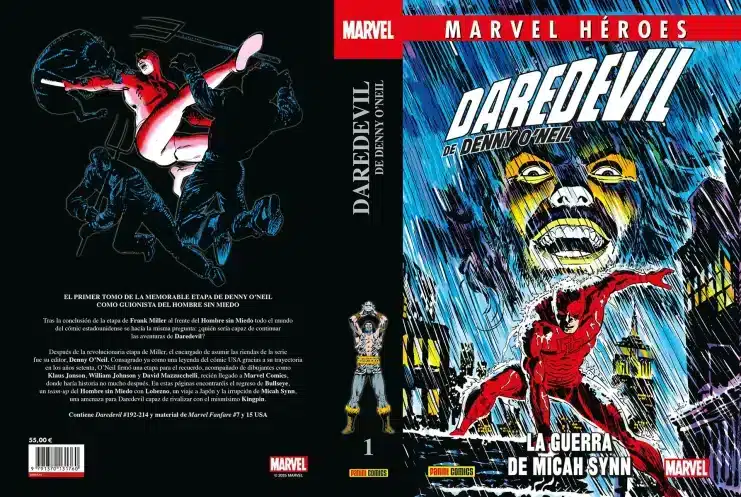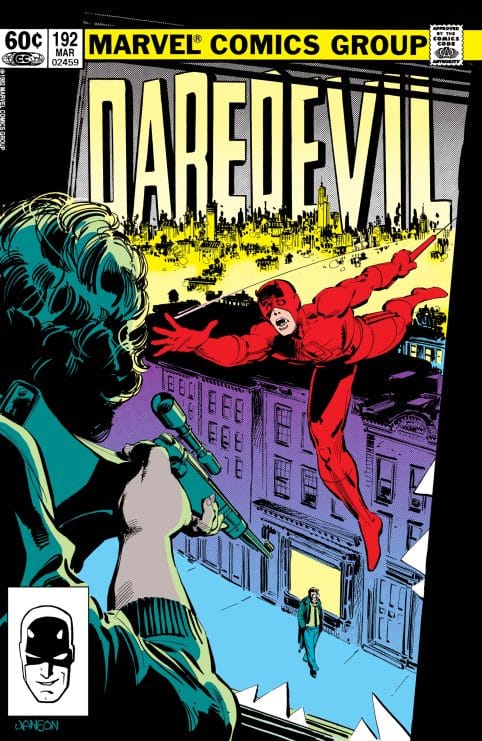

The first volume of Denny O’Neil’s Marvel Heroes of Daredevil line shows us the legacy of Frank Miller in a magnificent edition published by Panini Comics
The stadium of Denny O’Neil In Reckless He’s one of those who tends to fly a little under the radar but, when viewed from afar, reveals many nuances and twists that anticipate what the tone of the character would have been in the 1980s. It’s not the most remembered part of the character (and given how well it’s been treated in terms of authors since then Frank Miller has taken the reins to date (no surprise), but it has its charm, with a more human and dirty protagonist, who moves in an air of decadence that will become the character’s hallmark. Now Panini Comics start collecting that phase in your line Marvel Heroesof which we already have the first volume here…


Succeeded Miller
O’Neil arrives after the creative storm created by Miller. His time on Daredevil had set the bar so high that anyone who came after seemed doomed to live in his shadow. However, Denny O’Neil did something smart and, instead of trying to imitate Miller, decided to go his own way. O’Neil was a seasoned, veteran screenwriter Batman and in a thousand editorial battles (he had been editor of that same series), and he understood perfectly how an urban hero works. So what it does here is it goes back to Matt Murdock a certain normality, but without forgetting the residue left by its predecessor.
It is also believed that O’Neil wants to bring some hope back to the character. In the midst of so much drama, there are moments of humanity, even irony. Daredevil is once again a hero who allows himself to fail without losing his bearings. In a way, this phase serves as a transition between the disruptive Miller and what would come next Anna Nocenti Yes Giovanni Romita Jr.which would take the series onto more social and psychological terrain. Without O’Neil, we probably wouldn’t have taken the next step. But with everything and with this one thing must be clarified: however many virtues can be seen in this phase, it is clearly inferior to the immediately preceding phase.
The pace of the scripts is slower than in other times. You can see the influence of the author’s comics and a certain narrative maturity that was beginning to rub off Marvel Comics. There are no major crossovers or editorial tricks, just a story that grows little by little. And this, over time, is appreciated more and more. It may not be the brightest stage, but it’s one of the most honest.
Reading these issues today, it’s surprising how well some of the dialogue has aged. O’Neil has an ear for everyday conversations and makes even the most melodramatic moments seem natural. Matt Murdock discusses, doubts and contradicts himself. He is not a textbook hero and this, in the mid-eighties, was truly revolutionary.


Secondary to power
In these issues you can see that O’Neil wants to delve into Matt’s internal conflict, in his constant struggle to balance his life as a lawyer and his life as a vigilante. It’s not a scenario of big villains or mythical sagas (although there are some), but one more focused on the small cases, on the secondary ones, on the people who surround the hero. Foggy Nelson Yes Heather Glenn They continue to appear, but increasingly marked by the turbulence that Matt drags on. There is an attempt to resume the protagonist’s love life, but the tone is dark, with that melancholic air that would become a trademark of the house.
One of the most interesting aspects of this period is the way the writer plays with the morality of Daredevil. It doesn’t present him as a pristine hero, but as someone who makes bad decisions, who sometimes gets carried away by anger or guilt. This makes him more believable, closer and also gives him room to develop some of the more forgotten secondary characters, such as Ben Urichwho here begins to consolidate himself as an essential figure in the mythology of the character. The journalist of Daily trumpet He becomes the voice of the street, that moral gaze that observes the excesses of both crime and Daredevil himself.
As far as plots go, there’s a bit of everything. We see Daredevil take on petty criminals, petty gangsters, and even some strange experiments that flirt with the almost supernatural tone that O’Neil handled with ease. In this area we have a very interesting plot that involves Pinal yakuza already an attempt to restore his diminished faculties Bullseye through a graft adamantium. Obviously Glutton He will also be involved in this. But above all there is the clear intention to build an atmosphere. New York is almost a character in itself: dark, dangerous, but also full of life and humanity. It is no coincidence that these issues are published just when superhero comics begin to look towards the realistic, to lose the colorful splendor of the seventies.


Klaus Janson, indelible
And then there’s the drawing. During this section several artists alternate, but the main weight falls on them Klaus Jansonwhich came from being Miller’s inker and here takes on more graphic responsibilities. Janson has a loose line, a little awkward, but very expressive. His Daredevil is angular, nervous, a body in constant tension. The interesting thing is that he does not seek the classic beauty of the superhero, but rather conveys a sense of movement, of improvisation. There are panels where you can almost feel Matt’s tiredness and the weight of the New York night on his shoulders. Janson knows when to let the page breathe, uses shadows intelligently, and lets color help create mood.
There are also notable appearances by other cartoonists, such as William Johnsonwhich provides a cleaner, more narrative feel and gives some visual variety to the series. And above all a first timer Davide Mazzucchellistill light years from what would have been very soon. But in general the stage maintains an aesthetic coherence in which the tone of the street, almost noirremains stationary. The visual narrative feels more cinematic, more interested in staging than spectacle. In short, the work of both Janson and the other cartoonists gives O’Neil’s scripts exactly what they need.
Him tome published by Panini Comics In hard cover it contains 600 color pages with a format of 17 x 26 cm. and includes the translation of the American edition of the character’s regular series issues 192 to 214 and material from Marvel fanfare 7 and 15, plus an introduction written by Pedro Monje and a section of extra material at the end of the volume. The recommended retail price is €55 and it went on sale in September 2025.


Marvel Heroes. Daredevil by Denny O’Neil
After Frank Miller’s revolutionary period, The Man Without Fear entered a new era, for which Denny O’Neil, who had until then been the series’ editor, took literary control, with Klaus Janson remaining as artist and ensuring graphic continuity. Each adventure is a gritty exploration of humanity’s temptations and thwarted aspirations, seasoned with a touch of Marvel magic.
Meanwhile, Kingpin teams up with a yakuza group seeking to bind Bullseye’s broken spine with adamantium, in a saga that leads to DD 200 USA, uniting the blind hero with Wolverine and taking him to Japan for an epic revenge against the man who killed Elektra. Then, the arrival of a new artist, David Mazzucchelli, changes everything, going from young promise to master of comics at incredible speed, while Micah Synn emerges as a threat to Daredevil capable of rivaling the Kingpin himself.
Authors: Geof Isherwood, Jack Sparling, Arthur Byron Cover, Bill Mantlo, Klaus Janson, Steven Grant, William Johnson, Mike Carlin, Harlan Ellison, George Freeman, Denny O’Neil, David Mazzucchelli, Larry Hama, Roger McKenzie, Alan Brennert and Luke McDonnell

